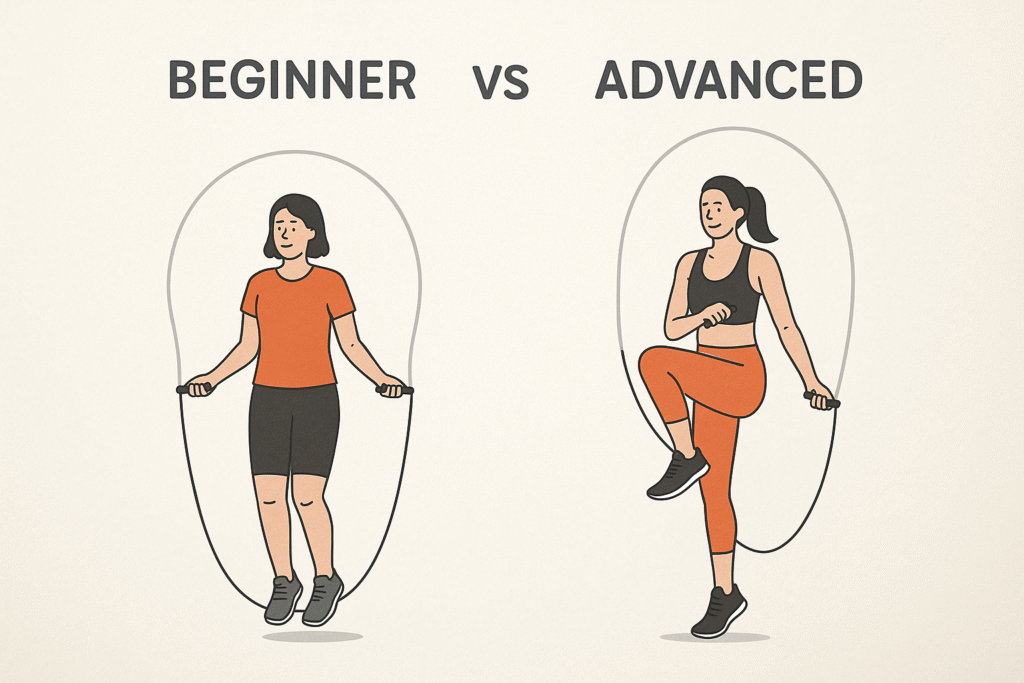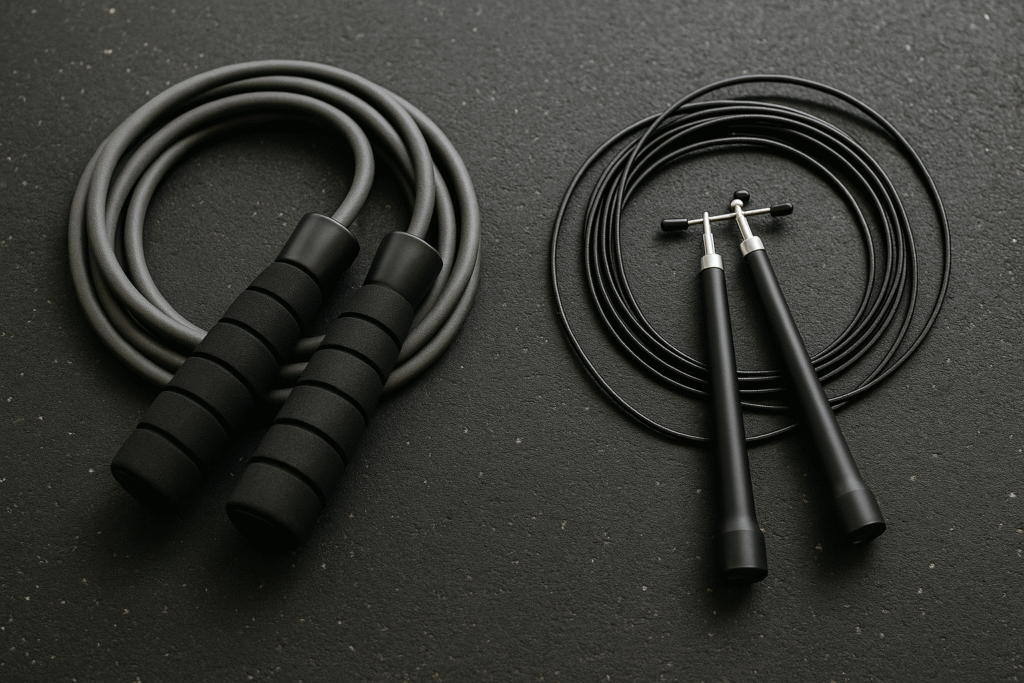Introduction: Why Jump Rope Is the Ultimate Fat-Burning Workout
When it comes to fast, effective, and affordable workouts, few exercises rival the jump rope. Whether you’re a fitness enthusiast, an athlete, or someone simply looking to shed a few extra pounds, jump rope is a calorie-torching, fat-burning powerhouse. What makes it so powerful is its ability to elevate your heart rate quickly, engage multiple muscle groups at once, and keep your metabolism revved long after the workout ends.
But just how many calories can you burn with jump rope? And how does it compare to other forms of exercise like running or cycling? In this complete fat-burning guide, we’ll break down the science of calorie burn, explore how different factors influence your results, and provide practical tips to maximize your jump rope workouts.
By the end of this guide, you’ll have everything you need to transform your jump rope into a serious fat-loss weapon.

Understanding Calories and Fat Loss
What Are Calories and How Do We Burn Them?
Calories are simply units of energy. The food and drinks you consume supply your body with calories, which you then burn through daily activities, exercise, and even at rest (this is called your basal metabolic rate).
When you burn more calories than you consume, your body taps into stored fat for energy, leading to weight loss. This principle is called the caloric deficit and is the foundation of fat loss.
The Science of Weight Loss and Energy Balance
Think of your body as a bank account. If you’re spending more money (calories burned) than you’re depositing (calories eaten), your balance (body fat) goes down. Exercise, especially high-intensity workouts like jumping rope, is one of the fastest ways to create that deficit.
Jump rope stands out because it doesn’t just burn calories during the activity—it also creates an afterburn effect (known as EPOC: Excess Post-Exercise Oxygen Consumption). That means your body continues to torch calories even hours after you’ve stopped skipping.
Jump Rope Calories Burned: How It Compares to Other Workouts
When comparing calorie-burning efficiency, jump rope consistently ranks at the top.
Jump Rope vs Running
Running burns around 10–12 calories per minute, while jump rope can burn 12–15 calories per minute depending on intensity. That means a 10-minute jump rope session = 30 minutes of jogging in terms of calorie burn.
Jump Rope vs Cycling
Cycling at a moderate pace burns about 8–10 calories per minute, which makes jump rope more efficient if you’re short on time.
Jump Rope vs HIIT Training
Jump rope itself can be turned into a HIIT workout. When done in intervals, it can rival advanced HIIT routines, combining cardio and strength elements seamlessly.
Factors That Influence Jump Rope Calories Burned
While jump rope is one of the most efficient calorie-burning workouts, the exact number of calories you torch depends on several factors:
Body Weight and Intensity
- A heavier person burns more calories during the same workout than a lighter person because the body has to work harder.
- Intensity matters too. Slow, casual skipping will not burn as much as fast-paced double unders or speed rope intervals.
Example:
- A 125-pound person may burn about 300 calories in 30 minutes.
- A 185-pound person can burn closer to 444 calories in 30 minutes.
Duration and Frequency
- Short bursts (5–10 minutes) are excellent for beginners.
- Longer sessions (20–60 minutes) are better for experienced skippers who want maximum fat loss.
- Consistency is key—3 to 5 times a week provides the best results.
Skill Level and Technique
- Beginners may waste energy with poor form, which can reduce efficiency.
- Proper technique—light jumps, good rhythm, and controlled breathing—helps maximize calorie burn while reducing injury risk.
Jump Rope Calories Burned by Weight and Time (Complete Chart)
Here’s a quick breakdown of average calorie burn by body weight and workout duration:
| Duration | 125 lbs (57 kg) | 155 lbs (70 kg) | 185 lbs (84 kg) |
| 10 minutes | ~100 calories | ~125 calories | ~150 calories |
| 30 minutes | ~300 calories | ~375 calories | ~444 calories |
| 60 minutes | ~600 calories | ~750 calories | ~888 calories |
As you can see, even a short 10-minute jump rope session packs a serious calorie punch—which is why many people use it as a quick fat-burning finisher after strength training.
Jump Rope for Fat Loss: Best Practices
If your goal is fat loss, jumping rope should be more than just bouncing up and down. Here are proven strategies to maximize results:
Interval Training with Jump Rope
- Alternate between high-intensity skipping (like sprinting with the rope) and low-intensity recovery.
- Example: 30 seconds fast, 30 seconds slow, repeat for 10–15 minutes.
Combining Strength and Cardio
- Mix jump rope intervals with bodyweight moves like push-ups, squats, and burpees.
- This creates a full-body HIIT workout, boosting both calorie burn and muscle development.
Proper Nutrition for Maximum Results
- Exercise alone isn’t enough—you need a caloric deficit to lose fat.
- Stick to whole foods: lean proteins, vegetables, whole grains, and healthy fats.
- Avoid excessive sugar and processed foods to prevent fat gain.
Benefits of Jump Rope Beyond Calories Burned
Jumping rope isn’t just about torching fat—it also strengthens your body and mind.
Cardiovascular Health
- Improves heart health by boosting endurance and circulation.
- Lowers risk of heart disease and hypertension.
Coordination and Agility
- Forces your brain and muscles to work together, improving balance, timing, and rhythm.
- This is why athletes—especially boxers—swear by jump rope training.
Bone Density and Strength
- Jumping rope is a weight-bearing exercise, which strengthens bones and reduces the risk of osteoporosis.
- Builds leg muscles, core stability, and even shoulder endurance.
Jump Rope Workouts for Different Fitness Levels
Not all jump rope workouts are the same. Here’s how to tailor your sessions:
Beginner-Friendly Workouts
- Start with basic single jumps for 1–2 minutes.
- Rest 30–60 seconds.
- Repeat 5–8 times for a 10-minute workout.
Intermediate Fat-Burning Routines
- Incorporate high knees, double unders, and side swings.
- Try a 20-minute routine with intervals (1 min jump, 30 sec rest).
Advanced Jump Rope Training
- Perform complex variations: crossovers, criss-cross, or triple unders.
- Push for 30–45 minutes with minimal rest, making it a true endurance challenge.

Common Mistakes to Avoid While Jumping Rope
Jump rope is simple, but mistakes can hold you back or cause injury.
Poor Form and Posture
- Jumping too high wastes energy. Aim for 1–2 inches off the ground.
- Keep elbows close to your body and use wrists to spin the rope, not your arms.
Skipping Warm-Ups and Cool Downs
- Cold muscles increase the risk of injury.
- Start with light dynamic stretches and end with calf and hamstring stretches.
Overtraining Risks
- Jump rope is high-impact. Too much can lead to shin splints or joint pain.
- Limit long sessions to 3–4 times a week if you’re just starting out.
Jump Rope Equipment Guide
The right gear can make your workouts more effective and comfortable.
Best Jump Ropes for Calorie Burning
- Speed ropes: Lightweight, fast, ideal for cardio.
- Weighted ropes: Increase resistance, burn more calories, and build strength.
Weighted vs Speed Ropes
- Weighted ropes are great for muscle building.
- Speed ropes are best for agility and endurance.

Shoes and Safety Gear
- Wear supportive sneakers with cushioning.
- Use a non-slip mat to protect joints and floors.
FAQs About Jump Rope Calories Burned
1. How many calories does 100 jump ropes burn?
On average, 100 basic jumps burn about 10–15 calories, depending on speed and weight.
2. Is jumping rope better than running for fat loss?
Yes. Jump rope burns more calories per minute than running and is easier on the body if done with proper shoes and technique.
3. Can I lose belly fat by jumping rope?
Spot reduction isn’t possible, but jump rope burns overall body fat. Over time, this reduces belly fat as part of total fat loss.
4. How long should I jump rope daily to lose weight?
Start with 10–15 minutes a day, then gradually build up to 30 minutes for maximum fat loss benefits.
5. Is jump rope safe for beginners?
Yes, but start slowly. Use a basic rope, practice good form, and avoid concrete surfaces to reduce joint stress.
6. Can I do jump rope every day?
If you’re a beginner, aim for 3–4 sessions weekly. Advanced athletes may do daily sessions but should listen to their bodies to avoid overuse injuries.
Conclusion: Why Jump Rope Should Be Your Go-To Fat-Burning Exercise
Jump rope isn’t just child’s play—it’s a serious calorie-burning, fat-melting workout that can rival or even outperform running, cycling, and many gym routines. With as little as 10 minutes a day, you can improve cardiovascular health, build coordination, and shed pounds effectively.
Whether you’re a beginner starting with short sets or an advanced athlete pushing through high-intensity intervals, jump rope is a versatile, affordable, and efficient tool to supercharge your fat-burning journey.
So grab a rope, lace up your sneakers, and start skipping your way to a healthier, leaner body!

